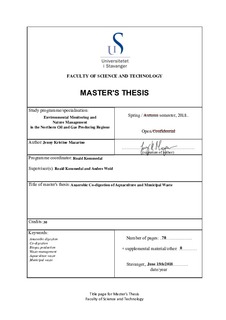| dc.contributor.advisor | Kommedal, Roald | |
| dc.contributor.author | Mazarino, Jenny Kristine | |
| dc.date.accessioned | 2018-10-16T14:06:37Z | |
| dc.date.available | 2018-10-16T14:06:37Z | |
| dc.date.issued | 2018-06-15 | |
| dc.identifier.uri | http://hdl.handle.net/11250/2568336 | |
| dc.description | Master's thesis in Environmental technology | nb_NO |
| dc.description.abstract | This study describes anaerobic co-digestion of aquaculture waste from Fister Smolt and municipal waste from IVAR SNJ. Both waste types are in rapid increase worldwide, yet production of biogas has mainly considered municipal waste as substrate thus far. There is a knowledge gap in the current understanding of co-digestion of aquaculture and municipal waste, and research and development are required.
The main objective of this study was to evaluate the biogas production potential and the stability of this co-digestion process. The biogas production potential and methane yield were assessed in anaerobic batch tests using the AMPTS II system. Produced methane corresponded to the amount of COD entering the batch test system, and around 70% COD of the aquaculture waste from Fister Smolt and the primary sludge from IVAR SNJ was converted to methane.
Results from the batch tests showed a 1% increase in methane yield when aquaculture waste and activated sludge from IVAR SNJ was co-digested. However, this value was regarded as too low to confirm an actual increase in methane yield. No increase in methane yield was observed when aquaculture and municipal waste was co-digested. Results from the daily fed stirred tank reactor showed a 6% increase in methane yield when aquaculture and municipal waste was co-digested. However, this value was also regarded as too low to confirm an actual increase in methane yield.
The process stability and performance were evaluated using daily fed stirred tank reactors. Four different reactors were set up with a SRT of 15 days. The primary sludge reactor and the co- digestion reactor experienced no inhibition. The aquaculture waste reactor experienced ammonia induced inhibition with an ammonia concentration of 50 mg/l, at a pH of 7.3 and an ammonium concentration of 1.6 g/l. An inhibited steady state was assumed when an increase in VFA concentration to 2100 mg/l reduced the ammonia concentration to 30 mg/l, as the pH was decreased. Methane was produced at a satisfying level. The pH adjusted aquaculture waste reactor on the other hand did not reach ammonia levels that were high enough to inhibit the performance of the reactor, and a more stable process was achieved.
It is possible to anaerobically digest aquaculture waste from Fister Smolt without adjustment of pH or co-digestion with primary sludge. However, nitrogen concentrations need to be closely monitored to avoid accumulation of ammonia. | nb_NO |
| dc.language.iso | eng | nb_NO |
| dc.publisher | University of Stavanger, Norway | nb_NO |
| dc.relation.ispartofseries | Masteroppgave/UIS-TN-IKBM/2018; | |
| dc.rights | Navngivelse 4.0 Internasjonal | * |
| dc.rights.uri | http://creativecommons.org/licenses/by/4.0/deed.no | * |
| dc.subject | anaerobic digestion | nb_NO |
| dc.subject | co-digestion | nb_NO |
| dc.subject | biogas production | nb_NO |
| dc.subject | waste management | nb_NO |
| dc.subject | aquaculture waste | nb_NO |
| dc.subject | municipal waste | nb_NO |
| dc.subject | miljøteknologi | nb_NO |
| dc.subject | akvakultur | nb_NO |
| dc.subject | offshore teknologi | nb_NO |
| dc.subject | offshore technology | nb_NO |
| dc.title | Anaerobic Co-digestion of Aquaculture and Municipal Waste | nb_NO |
| dc.type | Master thesis | nb_NO |
| dc.subject.nsi | VDP::Teknologi: 500::Miljøteknologi: 610 | nb_NO |

